Intermec Technologies RC11 RC11 User Manual PD4xum
Intermec Technologies Corporation RC11 PD4xum
Contents
User Manual part 2 of 4

23
22
Connecting and Configuring the Printer
Use this chapter to understand how to configure the printer to
communicate in your network. This chapter contains these
sections:
•Connecting the Printer to Your PC
•Connecting the Printer to Your Network
•Configuring the Printer
•Upgrading the Firmware
•Downloading Fonts and Graphics

Chapter 2 — Connecting and Configuring the Printer
24 PD41 and PD42 Commercial Printer User’s Guide
Connecting the Printer to Your PC
You can easily connect the PD41 or PD42 commercial printer to your
PC using one of these ports:
•USB device port
•RS-232 serial interface port
•IEEE 1284 communications port (optional)
Connecting the Printer to a PC Through the USB Device Port
Intermec recommends that you only connect one printer to each PC,
either directly, or through a hub. To connect the printer to a PC
through the USB device port, you need:
•USB Type B to USB Type A cable
•Intermec InterDriver® software
The USB cable you need is included in the shipping box with the
printer. The InterDriver printer driver is available on the
PrinterCompanion CD that ships with the printer. To make sure you
have the latest version of InterDriver, you may want to go to the
downloads page for the printer on www.intermec.com.
To connect the printer to a PC through the USB port
1Download and install the InterDriver software on your PC.
2Connect the USB cable to the Type B connector on the back of the
printer and connect the other end to your PC.
You do not need to set up any parameters for USB communications.
Connecting the Printer to a PC Through the Serial Port
The serial communication parameters control the communication
between the printer and the connected PC on the serial port, referred
to as “uart1:” on the printer.
Note: You cannot use the USB device port and IEEE 1284 port at the
same time. To select the active interface, go to Setup mode > COM: >
Interface.
Chapter 2 — Connecting and Configuring the Printer
PD41 and PD42 Commercial Printer User’s Guide 25
Make sure the serial port settings on the printer match the settings on
the connected device. The default serial communication settings on
the printer are: 9600 baud rate, 8 data bits, no parity, 1 stop bit and no
flow control.
You can use a serial connection to communicate with your PC and
run PrintSet, LabelShop, or InterDriver. You can also use the serial
port to send commands directly to the printer through a terminal
connection, for instance with Telnet.
To connect the printer to a PC through the serial port, you need:
•DB9 to DB9 RS-232 cable (P/N 1-974024-018)
To connect the printer to a PC through the serial port
1Connect one end of the RS-232 cable to the back of the printer and
connect the other end of the cable to a serial COM port on the PC.
2If necessary, change the PC serial port configuration to match
your printer.
Connecting the Printer to a PC Through the IEEE 1284 Port
You can use the parallel connection with LabelShop or the Intermec
InterDriver. The parallel port supports Universal Plug and Play
(UPnP) and additional status reporting through IEEE 1284 nibble ID
mode.
If you are using a parallel port to communicate with the printer, you
need:
•an IEEE 1284 interface adapter installed in the printer.
•a parallel cable to run between the printer and the PC.
If you did not have the parallel interface installed at the factory, you
can install the field installable option (P/N 1-971164-800) in the
optional I/O board port of your printer. You can purchase a parallel
cable from Intermec (P/N 1-974022-018) or from your local computer
store.
To connect your printer to a PC parallel port
•Connect the IEEE 1284 cable connector to the interface adapter
port on the back of the printer and connect the other end of the
cable into a parallel port on the PC.

Chapter 2 — Connecting and Configuring the Printer
26 PD41 and PD42 Commercial Printer User’s Guide
Connecting the Printer to Your Network
Using either the integrated Ethernet or the optional 802.11 wireless
network interface provides features such as security, FTP server, web
server, and Alert handling.
Setting Up Ethernet Communications
Use the Ethernet port to set up the PD41 or PD42 as a network
printer. The printer is set to automatically retrieve an IP number from
the network (DHCP) once it is turned on. You can use the network
connection either with LabelShop or the Intermec InterDriver. You
can also use it to directly send commands to the printer through a
terminal connection (Telnet), or you can send instructions via FTP.
For terminal connections, it utilizes the Raw TCP protocol through
port 9100.
To connect the printer to your network
1Connect the Ethernet cable to the Ethernet port in the rear of the
printer.
2Turn the printer on. Wait for the blue Ready-to-Work LED to stop
blinking, and for the message “IP configuration error” to
disappear from the screen.
3Enter Information mode by pressing ( ).
Information mode cycles through the interfaces installed on the
printer in five-second intervals and displays them on the screen.
The IP address is displayed under net1: in Fingerprint and net in
IPL.
4Enter the IP address of the printer in the address field of your web
browser (for example http://10.200.27.94) and press Enter.
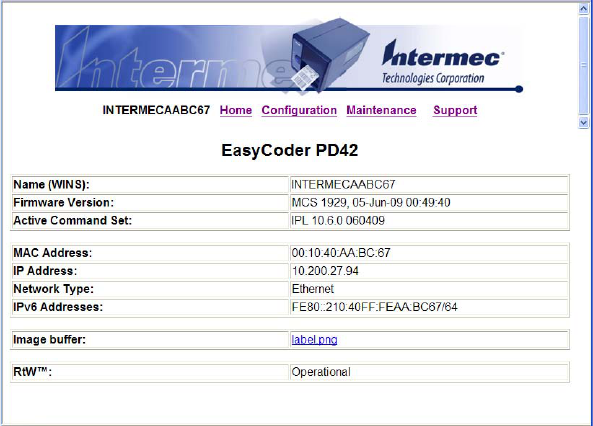
Chapter 2 — Connecting and Configuring the Printer
PD41 and PD42 Commercial Printer User’s Guide 27
Entering the IP address brings up the home page of the printer,
where you can check and modify printer settings.
5You will be prompted to enter a login name and a password. By
default, the login name is admin and the password is pass.
For more information on using the web page to configure the
printer, see “Configuring the Printer From the Home Page” on
page 38.
If your network does not assign IP numbers automatically, or the
Ready-to-Work indicator is flashing to indicate a network error, you
can use PrintSet (available on the PrinterCompanion CD or as a
download from www.intermec.com) to correct the network settings..

Chapter 2 — Connecting and Configuring the Printer
28 PD41 and PD42 Commercial Printer User’s Guide
Setting Up 802.11 Radio Communications
The printer can have an internal 802.11 b/g radio to transfer and
receive data using wireless communications. This user’s guide
assumes that you have already set up your wireless communications
network including your access points. The following procedures
include information on setting up wireless security for both IPL and
Fingerprint.
The printer supports these authentication modes: none, WEP, WPA
Personal and Enterprise mode (802.1x authentication), WPA2
Personal and Enterprise mode (802.1x authentication).
To set up the printer to work in your wireless network, you need these
items:
•Serial cable (P/N 1-974024-018)
•Host PC running Windows or Linux
•PrintSet. You can download PrintSet from the Downloads page
for your printer on www.intermec.com or you can download it
from the PrinterCompanion CD that shipped with your printer
•(optional) Serial port software such as Hyperterminal
To set up the printer for wireless communications using PrintSet
1Download and install PrintSet on your PC.
2Connect one end of the RS-232 cable to the back of the printer and
connect the other end of the cable to a serial COM port on the PC.
3If necessary, change the PC serial port configuration to match
your printer:
Note: WPA and WPA2 Enterprise mode and dynamic WEP currently
support PEAP, TTLS, LEAP, and EAP-Fast.
Parameter Default Setting
Baud rate 9600
Data bits 8
Parity None
Stop bits 1
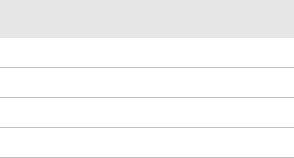
Chapter 2 — Connecting and Configuring the Printer
PD41 and PD42 Commercial Printer User’s Guide 29
1Start PrintSet on your PC.
2In the General Tasks box, click Add Printer and step through the
screens of the Add Printer Wizard until you have successfully
added your printer.
3In the Printer Tasks box, click Wireless Setup Wizard and step
through the screens to set up wireless network and security
parameters.
To set up the printer for wireless communications using
Hyperterminal
1Connect one end of the RS-232 cable to the back of the printer and
connect the other end of the cable to a serial COM port on the PC.
2On your PC, open HyperTerminal® and set these serial port
parameters:
.3From the host PC, check the wireless settings.
If you are using IPL, send these commands to the printer:
<STX><SI>wt,SSID<ETX>
<STX><SI>wt,WEP1<ETX>
<STX><SI>wt,WEP2<ETX>
<STX><SI>wt,WEP3<ETX>
<STX><SI>wt,WEP4<ETX>
<STX><SI>wt,AUTH<ETX>
<STX><SI>wt,WPA<ETX>
<STX><SI>wt,WPA2<ETX>
<STX><SI>wt,WPA_PSK<ETX>
<STX><SI>wt,ROAM<ETX>
<STX><SI>wt,PWR_MODE<ETX>
<STX><SI>wt,CHANNEL<ETX>
<STX><SI>wt,AP_MAC<ETX>
<STX><SI>wt,SIGNAL<ETX>
<STX><SI>wt,SPEED<ETX>
<STX><SI>wt,ACTIVE<ETX>
Parameter Default Setting
Baud rate 9600
Data bits 8
Parity None
Stop bits 1

Chapter 2 — Connecting and Configuring the Printer
30 PD41 and PD42 Commercial Printer User’s Guide
If you are using Fingerprint, send this command to the printer:
setup write "wlan","uart1:"
4Set up the printer to use the correct SSID and authentication
modes. For help, see the next section, Configuring Wireless
Printing Using IPL or “Configuring Wireless Printing Using
Fingerprint” on page 33.
5If you are going to use certificates for validation, transfer the
certificate to the printer. The printer can accept .pfx, .pem, and
.der certificates.
6Verify that the printer is connected to the access point and make
sure it has an IP address allocated to it.
Use the following sections to set most of your wireless
communication settings. For help with additional commands and
information, see either the Fingerprint Command Reference Manual (P/N
937-005-xxx) or the IPL Command Reference Manual (P/N 937-007-xxx).
You can download both documents from the Intermec web site at
www.intermec.com.
Configuring Wireless Printing Using IPL
Use the following procedures to configure your printer with IPL for
wireless printing.
To configure the printer to use WEP authentication
1Send the following commands to login as an admin and set the
SSID:
<STX><ESC>.x,su -p pass admin<ETX>
<STX><SI>ws,SSID,xxxxx<ETX>
where xxxxx can be from 0 to 32 ASCII characters, not including
the double quote.
2Send the following commands to configure the WEP keys. The
following example sets WEP key 1 to 1234 and enables WEP key 1.
<STX><SI>ws,WEP1, 0x0001020304<ETX>
Note: The default password for logging in as an admin is “pass.” If
you have changed the password, you will need to use your password
instead of “pass.”

Chapter 2 — Connecting and Configuring the Printer
PD41 and PD42 Commercial Printer User’s Guide 31
<STX><SI>ws,.WEP_KEY,1<ETX>
3Send the following command to activate the settings.
<STX><SI>ws,ACTIVE,1<ETX>
To configure the printer to use WPA-PSK or WPA2-PSK mode
1Send the following commands to login as an admin and set the
SSID:
<STX><ESC>.x,su -p pass admin<ETX>
<STX><SI>ws,SSID,xxxxx<ETX>
where xxxxx can be from 0 to 32 alphanumeric characters
2Send one of the following commands to turn on WPA or WPA2
authentication. Send the WPA-PSK or WPA2-PSK command to set
a pre-shared key:
<STX><SI>ws,WPA,ON<ETX>
<STX><SI>ws,WPA2,ON<ETX>
<STX><SI>ws,WPA_PSK, xxxxxxxxxx<ETX>
where xxxxxxxxxx is a value between 8 and 64 characters.
3Send the following command to activate the settings:
<STX><SI>ws,ACTIVE,1<ETX>
To configure the printer to use WPA or WPA2 Enterprise mode
1Send the following commands to login as an admin and set the
SSID:
<STX><ESC>.x,su -p pass admin<ETX>
<STX><SI>ws,SSID,xxxxx<ETX>
where xxxxx can be from 0 to 32 alphanumeric characters.
2Send one of the following commands to enable WPA-802.1x or
WPA2-802.1x authentication. You should also send the WPA_PSK
command that does not contain a value:
<STX><SI>ws,WPA,ON<ETX>
Note: The default password for logging in as an admin is “pass.” If
you have changed the password, you will need to use your
password instead of “pass.”
Chapter 2 — Connecting and Configuring the Printer
32 PD41 and PD42 Commercial Printer User’s Guide
<STX><SI>ws,WPA2,ON<ETX>
<STX><SI>ws,WPA_PSK, <ETX>
3Send these commands to configure the EAP_TYPE:
<STX><SI>ws,EAP_TYPE,xxxx<ETX>
where xxxx can be OFF, LEAP, PEAP, or TTLS.
<STX><SI>ws,.EAP_USER,xxxx<ETX>
<STX><SI>ws,.EAP_PASS,xxxx<ETX>
where xxxx is the unique username and the unique password for
this protocol.
4If you are using TTLS, you may need to send this command to set
the TTLS outer name:
<STX><SI>ws,TTLS_USER, xxxx <ETX>
where xxxx is the outer name.
5If you are using certificates for validation, here are some
commands you may need to use.
•Send the following commands to set a certificate and enable
validation:
<STX><SI>ws,CA_CERT,c:/testCA.pfx@export<ETX>
<STX><SI>ws,VALIDATE,ON<ETX>
where c:/testCA.pfx is the location and name of the certificate
and export is the passphrase.
•Send the following commands to set a common name for
server 1 and server 2:
<STX><SI>ws, .SERVER_CN1,xxxxxxxxxx <ETX>
<STX><SI>ws, .SERVER_CN2,xxxxxxxxxx <ETX>
where xxxxxxxxxx can be a value from 0 to 64 characters.
•Send the following command to make sure your values match
those used by the access point:
<STX><SI>wt,[variable name]<ETX>
All variables are returned with the exception of EAP_PASS
which always returns “****” if configured and CA_CERT

Chapter 2 — Connecting and Configuring the Printer
PD41 and PD42 Commercial Printer User’s Guide 33
which transmits the name of the last certificate authority
successfully installed. An additional read-only variable for the
supplicant state, called STATE, is also returned.
•You may need to send the following command several times for
the wireless station to connect:
<STX><SI>ws,ACTIVE,1<ETX>
Configuring Wireless Printing Using Fingerprint
Use the following procedures to configure your printer with
Fingerprint for wireless printing.
To configure the printer to use WEP authentication
1Send the following commands to login as an admin and set the
SSID:
run"su -p pass admin"
setup write "wlan","uart1:"
setup "wlan","SSID","xxxxx"
where xxxxx can be from 0 to 32 ASCII characters, not including
the double quote.
2Send the following commands to configure the WEP keys. The
following example sets WEP key 1 to 1234 and enables WEP key 1.
setup "wlan","WEP1","0x0001020304"
setup "wlan",".WEP_KEY","1"
setup "wlan","ACTIVE","1"
setup write "wlan","uart1:"
To configure the printer to use WPA-PSK or WPA2-PSK mode
1Send the following commands to login as an admin and set the
SSID:
run"su-p pass admin"
setup write "wlan","uart1:"
setup "wlan","SSID","xxxxx"
where xxxxx can be from 0 to 32 alphanumeric characters.
Note: The default password for logging in as an admin is “pass.” If
you have changed the password, you will need to use your
password instead of “pass.”
Chapter 2 — Connecting and Configuring the Printer
34 PD41 and PD42 Commercial Printer User’s Guide
2Send one of the following WPA/WPA2 ON commands to turn on
WPA or WPA2 authentication. Send the WPA-PSK or WPA2-PSK
command to set a pre-shared key:
setup "wlan","WPA","ON"
setup "wlan","WPA2","ON"
setup "wlan","WPA_PSK","xxxxxxxxxx"
setup "wlan","ACTIVE","1"
setup write "wlan","uart1:"
where xxxxxxxxxx is a value between 8 and 64 characters.
To configure the Printer to use WPA or WPA2 Enterprise mode
1Send the following commands to login as an admin and set the
SSID:
run"su-p pass admin"
setup write "wlan","uart1:"
setup "wlan","SSID","xxxxx"
where xxxxx can be from 0 to 32 alphanumeric characters.
2Send one of the following WPA/WPA2 ON commands to set up
WPA-802.1x or WPA2-802.1x authentication. You should also
send the WPA_PSK command that does not contain a value:
setup "wlan","WPA","ON"
setup "wlan","WPA2","ON"
setup "wlan","WPA_PSK",""
setup write "wlan","uart1:"
•To view the 802.1x values, send this command:
setup write "8021x","uart1:"
3Send these commands to configure the EAP_TYPE:
setup "8021x","EAP_TYPE","xxxx"
where xxxx can be OFF, LEAP, PEAP, or TTLS.
setup "8021x",".EAP_USER","xxxx"
setup "8021x","EAP_PASS","xxxx"
where xxxx is the unique username and the unique password for
this protocol.
4If you are using TTLS, you may need to send this command to set
the TTLS outer name:
setup "8021x","TTLS_USER","xxxx"
where xxxx is the outer name.
Chapter 2 — Connecting and Configuring the Printer
PD41 and PD42 Commercial Printer User’s Guide 35
5If you are using certificates for validation, here are some
commands you may need to use.
•Send the following commands to set a certificate and enable
validation:
setup "8021x","CA_CERT","c:/test.pfx@export"
setup "8021x","VALIDATE","ON"
where c:/test.pfx is the location and name of the certificate and
export is the passphrase.
•Send the following commands to set a common name for
server 1 and server 2:
setup "8021x",".SERVER_CN1","xxxxxxxxxx"
setup "8021x",".SERVER_CN2","xxxxxxxxxx"
where xxxxxxxxxx can be a value from 0 to 64 characters.
•Send the following command to make sure your values match
those used by the access point:
setup write "8021x","uart1:"
•You may need to send the following command several times for
the wireless station to connect:
setup "wlan","ACTIVE","1"<ETX>
Connecting Peripherals to the USB Host Port
You can connect these peripheral devices to the USB host interface
port on the printer:
•USB mass storage device
•Keyboard
•Bar code scanner
•USB hub
Connecting a USB Mass Storage Device to the USB Host Port
You can use a USB mass storage device to store additional fonts and
images for the printer. You can also use the device to upgrade your
firmware. For more information on using the mass storage device to
upgrade the printer, see“Upgrading the Firmware” on page 54.

Chapter 2 — Connecting and Configuring the Printer
36 PD41 and PD42 Commercial Printer User’s Guide
Connecting a Keyboard to the USB Host Port
You can use an external USB keyboard to:
•input data in Fingerprint applications. Some applications may
require more complex input from users than the simple push of a
button.
•manage setup in Fingerprint, Direct Protocol, and IPL. In the
installed keyboard layouts, the arrow keys on the keyboard are
mapped to the up, down, right, and left functions in the Setup
menu. The five function keys F1 to F5 correspond to the five soft
keys on the front panel, starting from the left. The Enter key will
have the same apply and select function.
The printer comes with four keyboard layouts installed (US, Swedish,
French, and German).
To change keyboard layout
1Plug your USB-keyboard into the USB connector in the back of
the printer.
2Turn the printer on.
3Press Setup ( ).
4Navigate to COM > USB KEYBOARD.
5Choose a keyboard layout.
6Exit Setup by pressing ( ).
Fingerprint users can create their own custom keyboard layouts. For
help, see the Fingerprint Command Reference Manual.
Connecting a Bar Code Scanner to the USB Host Port
You can connect a bar code scanner of HID (Human Interface Device)
type to the printer. The scanner will send data to the “console:” device
in the same way as a USB keyboard. You can then use this data in a
Fingerprint application.
The keyboard layout you choose in setup (see previous procedure)
applies for connected scanners too.
Note: You can only use a bar code scanner with printers that are
running Fingerprint firmware.

Chapter 2 — Connecting and Configuring the Printer
PD41 and PD42 Commercial Printer User’s Guide 37
Connecting a USB Hub to the USB Host Port
You can connect a USB hub to the printer so that you can connect
several USB devices to the printer at the same time.
Configuring the Printer
You can change the configuration settings of your printer:
•directly from the screen.
•from the printer home page.
•using PrintSet.
•using commands sent from your PC.
•remotely using SmartSystems Foundation.
Configuring the PD42 Printer from the Screen
To configure the PD42 printer from the screen, you need to enter
Setup mode.
To enter Setup mode
•Press the button.
While in Setup mode, use the soft keys to navigate. For help using the
soft keys, see “Understanding the PD42 Screen and Soft Keys” on
page 8.
Use the following illustrations to understand the Setup menu. The
main nodes of the setup tree are organized in a loop. You can view
detailed illustrations of each menu in Appendix C “IPL and
Fingerprint Setup Menus” on page 107. Each main node branches
out to a number of sub-nodes. At startup, the firmware determines if
optional equipment such as a cutter or an interface board is installed
in the printer, and these are added to the Setup tree.
Note: You can only connect one mass storage device and one HID
(keyboard or scanner) peripheral to the USB hub at a time.
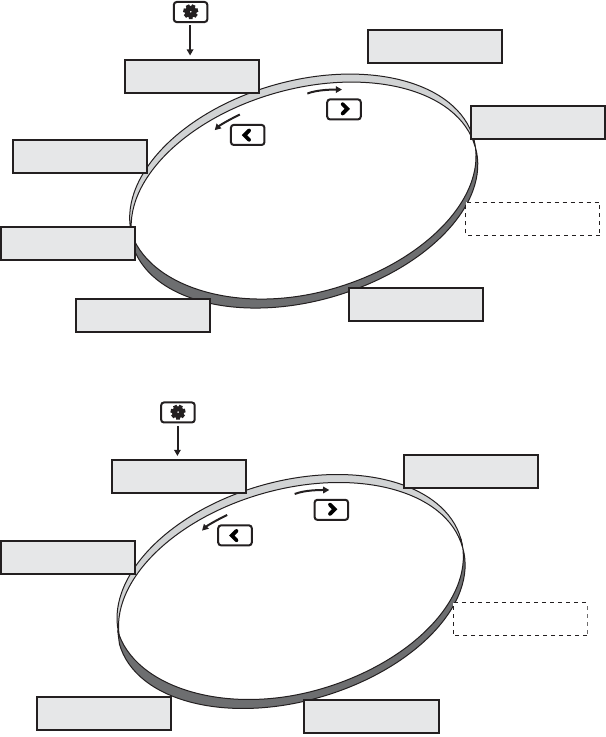
Chapter 2 — Connecting and Configuring the Printer
38 PD41 and PD42 Commercial Printer User’s Guide
The Main Nodes of the Setup Menu in Fingerprint
The Main Nodes of the Setup Menu in IPL
Configuring the Printer From the Home Page
If you are using an Ethernet or 802.11 wireless connection, you can
change configuration settings from the home page of the printer.
To access the home page of the printer
1Start your web browser.
2In the address field, type the IP address of your printer and press
Enter. The home page of your printer appears.
SETUP:
SER-COM, UART1
SETUP:
PRINT DEFS
SETUP:
MEDIA
SETUP:
FEEDADJ
SETUP:
NETWORK
Option
Starting point
SETUP:
COM
SETUP:
EMULATION
SETUP:
NET-COM, NET1
SETUP:
SER-COM
SETUP:
CONFIGURATION
SETUP:
MEDIA SETUP:
TEST/SERVICE
SETUP:
NETWORK
Option
Starting point
SETUP:
COM
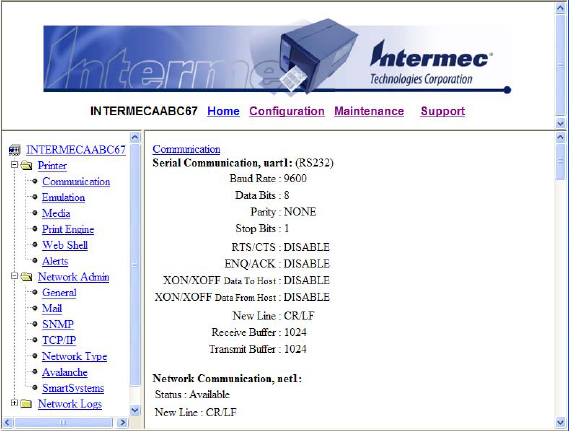
Chapter 2 — Connecting and Configuring the Printer
PD41 and PD42 Commercial Printer User’s Guide 39
The home page displays the assigned name, firmware version,
Active Command Set, MAC address, and IP address of your
printer. The home page also displays the contents of the image
buffer, as well as the status of the Ready-to-Work indicator.
3Click Configuration.
4Click the link for the settings you want to configure.
5You will be prompted to enter a login name and a password. By
default, the login name is admin and the password is pass.
Use the next sections to understand and configure the settings in each
configuration page.
Configuring Communications Settings
Use the communications page to configure serial communications,
the communications interface, and the keyboard layout.
To configure communications settings
1Click Printer > Communication.
2Choose the settings you want to change.
3Click Submit Setup.
Chapter 2 — Connecting and Configuring the Printer
40 PD41 and PD42 Commercial Printer User’s Guide
Configuring Media Settings
Use the media page to view and change media settings such as
XSTART position, media type, and contrast.
To configure media settings
1Click Printer > Media.
2Enter the correct information for the media you are using.
3Click Submit Setup.
Configuring Print Engine Settings (Fingerprint only)
Use the print engine page to adjust the media feed direction (start and
stop adjust positions) and print speed. The value of the head
resistance is read-only and is measured by the firmware when the
printer starts up.
To configure print engine settings
1Click Printer > Print Engine.
2Enter the correct information for the print engine.
3Click Submit Setup.
Configuring Web Shell Settings
Use the Web Shell page to view and change test and default settings.
You can also use the Web Shell page to print test labels and change the
command language.
To configure Web Shell settings
1Click Printer > Web Shell.
2Select the action you want to take or the setting you want to
change.
•For the actions in the top of the screen, the printer performs
the action and may prompt you to reboot the printer.
•For the settings in the bottom of the screen, select your desired
settings and click Submit Setup. You will receive a message
that reads “Application change will take effect at reboot.” You
can choose to select Reboot or wait until you are done making
other configuration changes.
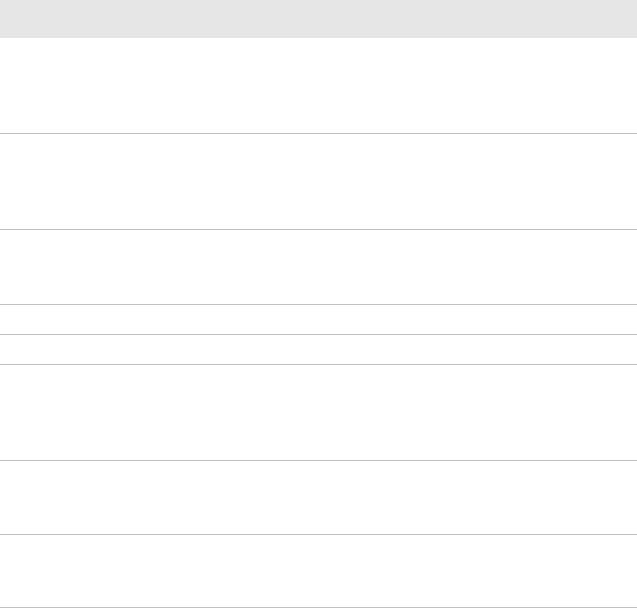
Chapter 2 — Connecting and Configuring the Printer
PD41 and PD42 Commercial Printer User’s Guide 41
Use the following table to understand the Web Shell settings.
Configuring Alerts
Use the Alerts page to view and change the printer alert settings.
To configure alerts
1Click Printer > Alerts.
2Change the alert settings:
•Choose Enabled or Disabled from the Setting list.
•Specify a Delay repeat in the text field.
•Select seconds or occurrences in the Delay Unit list.
•Enter a message in the Message text field.
Understanding the Web Shell Settings
Setting Description
Testfeed [value] Calibrates the label stop sensor performs a
testfeed. Selecting this setting is equivalent to
issuing the TESTFEED command on the
printer.
Ribbon Sensor [value] Calibrates the ribbon sensor. The ribbon sensor
is also calibrated by the testfeed. You only see
this setting if the ribbon sensor is installed in
the printer.
Default Setup Returns the printer to factory default settings.
Passwords, alerts, and the selected application
are not changed.
Reboot Reboots the printer.
Print Test Label Prints the predefined test label you choose.
Command Language Sets the command language to Fingerprint,
Direct Protocol, IPL, ESim, ZSim, or DSim. You
need to reboot the printer for the change to take
effect.
Fingerprint Application Defines the application to run as the default on
startup. You need to reboot the printer for the
change to take effect.
Standard I/O Defines the port the printer listens to. You need
to reboot the printer for the change to take
effect.
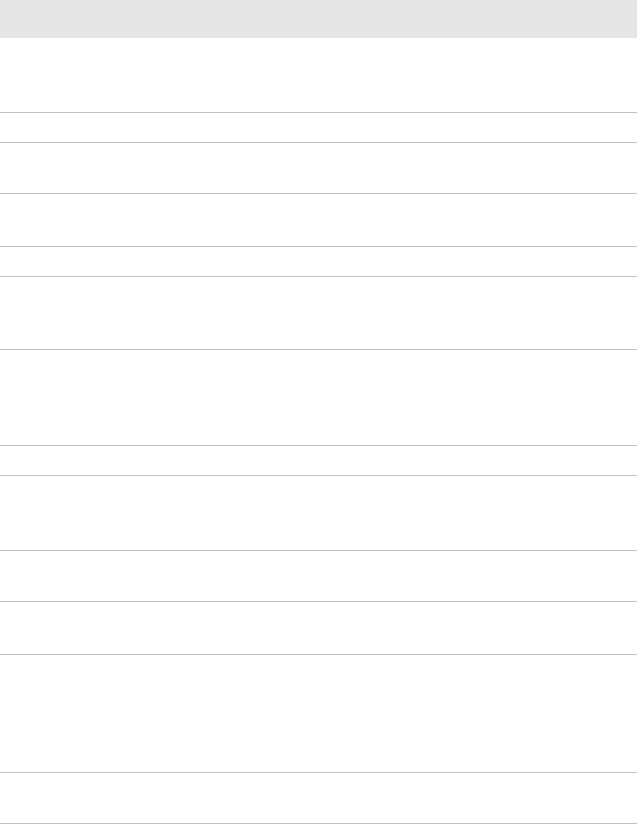
Chapter 2 — Connecting and Configuring the Printer
42 PD41 and PD42 Commercial Printer User’s Guide
3Select the Notification method.
4Click Submit Settings.
Use the following table to understand the Alert Settings.
Understanding the Alert Settings
Setting Description
Label Not Taken
(Fingerprint only)
Sent when the printed label is not taken from the
printer. This setting applies to label and ticket media
and requires an optional label taken sensor.
Cutter Error There was an error related to the label cutter.
Head Lifted A printer job was sent to the printer while the
printhead was lifted.
Out of Ribbon You have thermal transfer ribbon selected and the
printer is out of ribbon.
Out of Paper The printer is out of media.
Ribbon Low The diameter of the remaining roll of ribbon is lower
than a specified value. You can specify the value in
the Media settings page.
Pause Mode The diameter of the remaining roll of media is lower
than a specified value. You can specify the value in
the Media settings page. This alert is only shown if
the sensor (which one?) is installed.
Setup Mode The printer is in Setup mode.
Error Condition
(Fingerprint only)
An error has occurred in the Fingerprint application.
The error does not have to be critical to the print job
for the printer to send this alert.
Application Break
(Fingerprint only)
A running Fingerprint application has been
interrupted manually or because of an error.
Print Job Complete
(Fingerprint only)
The print job has been successfully completed.
Odometer Count 1 The amount of media printed has reached a preset
amount, measured in meters or in number of labels.
The Delay repeat setting represents how often the
alert message will be sent when the preset value is
reached.
Notification Method The method used to send an alert message. You can
choose from mail, SNMP-trap, or both.
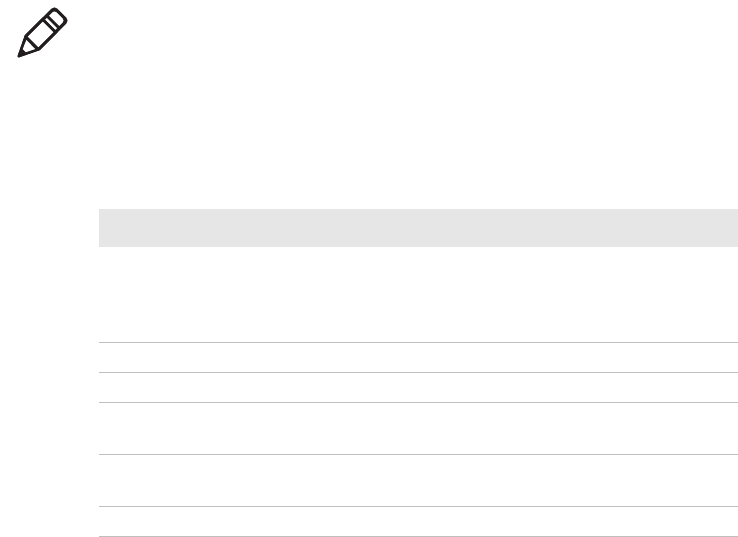
Chapter 2 — Connecting and Configuring the Printer
PD41 and PD42 Commercial Printer User’s Guide 43
Configuring General Network Settings
Use the General network page to view the printer name, change
passwords, and set restrictions.
To configure general network settings
1Click Network Admin > General.
2View or update your settings.
3Click Submit General settings.
Use the following table to understand the general network settings.
Note: To enter a new password, you need to check the Set
password check box.
Understanding the General Network Settings
Setting Description
Printer Name The network identification name (WINS name)
of the printer. The default name is INTERMEC
followed by the last six positions of the MAC
address.
System Location (Optional) The printer location.
System Contact (Optional) The printer administrator.
Set Password You must check this box if you want to change
the admin password.
Old Admin Password You need to enter the old password before you
can change the password.
New Admin Password The new password you want to use.

Chapter 2 — Connecting and Configuring the Printer
44 PD41 and PD42 Commercial Printer User’s Guide
Configuring Mail Settings
Use the mail settings page to view and change email (SMTP) server
settings.
To configure mail settings
1Click Network Admin > Mail.
2Select the mail server settings and enter mail addresses.
3Click one of these buttons:
•Submit Mail Settings to send the changes to the printer.
•Submit & Send test mail to send the changes to the printer
and test your new settings.
Use the following table to understand the mail settings.
Restrictions Sets restrictions on who is allowed to upgrade
the printer firmware or view and change
network settings. You cannot remove “admin”
from the list of authorized users.
Users allowed to update: Defines who may
perform a firmware upgrade using FTP,
PrintSet, or IFAB. This setting does not affect
upgrading from a Compact Flash card.
Users allowed to read/write protected LAN1
settings: (Fingerprint only) Defines who may
read/write settings in the LAN1 section.
Users allowed to change network settings:
(Fingerprint only) Defines who may change the
network node in the setup. This setting is not
supported if you are setting up the printer from
its internal keyboard.
Users allowed to change wireless settings:
Defines who may change WLAN or 802.1x
settings.
Understanding the General Network Settings (continued)
Setting Description

Chapter 2 — Connecting and Configuring the Printer
PD41 and PD42 Commercial Printer User’s Guide 45
Configuring SNMP Settings
Use the SNMP page to view and change SNMP settings.
To configure SNMP settings
1Click Network Admin > SNMP.
2Change the SNMP settings.
3Click Add to add trap settings. You can define up to four
authentication failure traps.
After you add a trap, it appears in the Trap Address Settings list.
You can edit or delete each trap in the list by clicking Edit or
Delete.
4Click Submit SNMP settings.
Understanding the Mail Settings
Setting Description
Mail (SMTP) Server Choose a configuration method for your mail
server settings:
•SMTP settings from DHCP: Choose this
setting is you want the printer to receive settings
automatically from your DHCP server. This
setting requires that you choose DHCP and IP
Selection in the TCP/IP section.
•Manual settings: Choose this option to
manually configure the Mail Server address and
port. The default port is 25.
Mail addresses Defines the email addresses to use when the
printer sends alert messages:
•From address: The address that displays as the
sender of alert messages. Email will be returned
to this address if the recipient is unreachable.
To prevent email bounces when the recipient is
unreachable, leave this field empty.
•To address: The recipient of alert messages. To
enter several addresses, separate them with a
comma (,) or a semicolon (;).
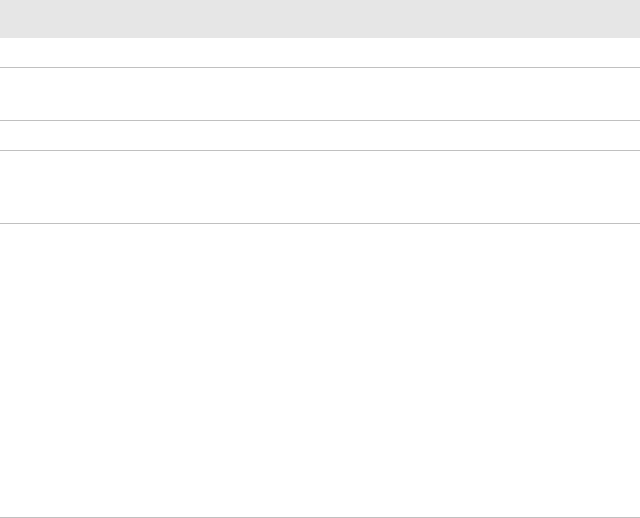
Chapter 2 — Connecting and Configuring the Printer
46 PD41 and PD42 Commercial Printer User’s Guide
Use the following table to understand SNMP settings.
Configuring TCP/IP Settings
Use the TCP/IP settings page to view and change TCP/IP network
settings.
To configure TCP/IP settings
1Click Network Admin > TCP/IP.
2View or update your settings.
3Click Submit TPC/IP settings.
Understanding the SNMP Settings
Setting Description
Read Community Community with rights to read the SNMP MIBs.
Read/Write
Community
Community with rights to read and write SNMP
MIBs.
System Name Administrative name for the SNMP node.
Authentication Failure
Trap
Defines if a trap is sent when an unauthorized
SNMP request tries to access the printer. Choose
Enable to send the trap.
Trap Address Settings Click Add to specify these trap address settings:
•Trap Address: IP address of the receiver of
SNMP traps. You can specify up to four trap
addresses.
•Trap Port: The port where SNMP traps are sent.
The default port if 162.
•Trap Community: Defines the community to
which SNMP traps will be sent.
•Friendly Name: A user-defined text string that
identifies the trap.
•Trap Enable Status: Defines whether the
specified trap is enabled.

Chapter 2 — Connecting and Configuring the Printer
PD41 and PD42 Commercial Printer User’s Guide 47
Use the following table to understand the TCP/IP settings.
Understanding the TCP/IP Settings
Setting Description
IPV4 Settings Configuration method: The method by which
an IP address is assigned to the printer. You can
choose between DHCP, BOOTP, BOOTP+DHCP,
or MANUAL.
Address: The current IP address of the printer.
Netmask: Manually assigned netmask for the
printer.
Default Router: The IP address of the default
router.
IPV6 Settings Configuration method: The method by which
an IP address is assigned to the printer. You can
choose between:
•AUTO: The IP address is obtained using
stateless auto-configuration. This is the
default configuration method.
•AUTO+DHCP: The IP address is obtained
using stateless auto-configuration, but DNS
options are obtained using DHCP.
•DHCP: The IP address and DNS options are
obtained using DHCP.
•MANUAL: The IP address is set to a static
address that you enter in the Static Address
field.
Current addresses: A list of all the currently
configured IP addresses for the Ethernet
interface. The address starting with FE80:: is the
link-local address and is available regardless of
the configuration method you choose.
Static address: This address applies if you
selected manual as the configuration method.
The IP address is specified as an address and a
prefix separated by a slash. You can use “::” to
represent a large number of consecutive zeros.
You should typically set the prefix to 64.
Example:
2001:DB8:0:F101::2/64
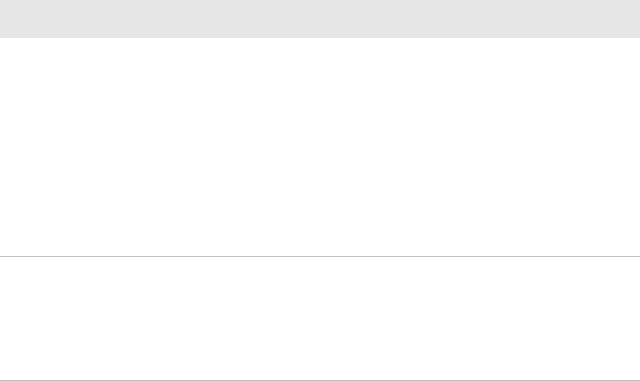
Chapter 2 — Connecting and Configuring the Printer
48 PD41 and PD42 Commercial Printer User’s Guide
Configuring the Network Type
Use the Network Type page to choose whether you are using an
Ethernet or wireless 802.11 network.
To configure the network type
1Click Network Admin > Network Type.
2Select either Ethernet or Wireless 802.11.
3Click Submit new settings.
4Reboot the printer for the changes to take effect.
Configuring Avalanche Settings
Use the Avalanche page to view and change Wavelink Avalanche
settings.
To configure Avalanche settings
1Click Network Admin > Avalanche.
2View or update your settings.
3Click Submit Avalanche settings.
Name Resolution DNS Server: The IP address of the name server.
DNSv6 Server: The IP address of the name
server for IPv6.
WINS Server (Primary and Secondary): The IP
addresses of the primary and secondary WINS
servers. If you chose DHCP or BOOTP for the
configuration method, you may see the currently
assigned WINS IP addresses depending on the
configuration of your DHCP server.
Printer Service NET1 TCP Port Number: The port number for
raw TCP. The default is 9100.
NET1 Queuing: Determines whether queuing
for the TCP port is turned on, off, or enabled for
multiple network connections (Multi).
Understanding the TCP/IP Settings (continued)
Setting Description
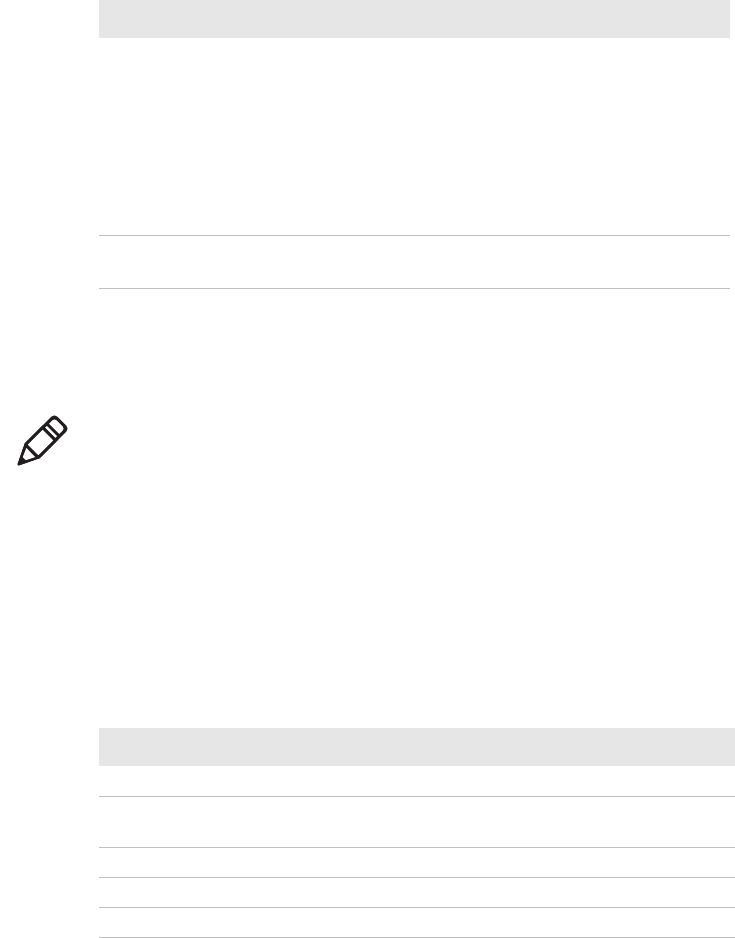
Chapter 2 — Connecting and Configuring the Printer
PD41 and PD42 Commercial Printer User’s Guide 49
Use the following table to understand the Avalanche settings.
Configuring Wireless LAN Settings
Use the Wireless LAN page to view and change 802.11 settings.
To configure wireless LAN settings
1Click Network Admin > Wireless LAN.
2View or update your settings.
3Click Submit 802.11 settings.
Use the following table to understand the Wireless LAN settings.
Understanding the Avalanche Settings
Setting Description
Enabler Mode Click one of the option buttons:
•Disabled: Disables Avalanche.
•Manual settings: Enables Avalanche. You
need to enter the Agent address and Port in
the text fields.
•Find agent by broadcast: Enables Avalanche
and the network connection broadcasts to
find the agent.
Agent authorization Enter your user name and password in the entry
fields.
Note: You will only see the Wireless LAN settings if your printer has
the wireless interface option installed and the printer is using
Fingerprint 8.77 or later.
Understanding the Wireless LAN Settings
Setting Description
SSID The network name of the printer.
Mode Set the operating mode of the device to Ad-Hoc or
Infrastructure.
WEP Set Wired Equivalent Privacy (WEP) to on or off.
WEP Keys You can enter values for up to 4 WEP keys.
Active WEP key Chooses the active WEP key.
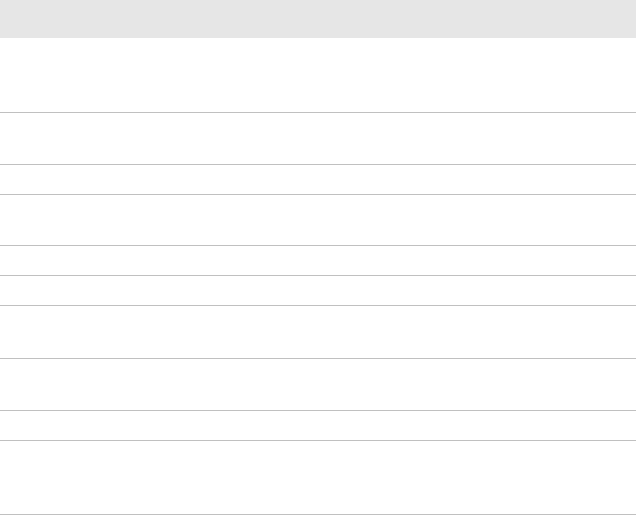
Chapter 2 — Connecting and Configuring the Printer
50 PD41 and PD42 Commercial Printer User’s Guide
Configuring 802.1x Settings
You only see the 802.1x settings page if you have the optional wireless
interface installed in your printer. Use the 802.1x page to view and
change 802.1x security settings.
To configure 802.1x settings
1Click Network Admin > 802.1x.
2View or update your settings.
3Click Submit 802.1x settings.
Authentication Sets the type of authentication for you use for WEP
keys. You can choose between Auto, Open System,
and Shared.
WPA Sets the Wi-Fi Protected Access (WPA) to either on
or off.
WPA Pre-shared key Sets the WPA Pre-shared key.
WPA2 Sets the Wi-Fi-Protected Access version 2 to either
on or off.
Roaming setting Sets the roaming reluctancy to 1, 2 or 3.
Current channel (Read only) The MAC address of the access point
AP MAC Address (Read only) MAC address of the access point to
which the printer is connected.
Signal strength (Read only) Radio signal strength of the access
point.
Speed (Read only) Speed of the current connection.
Region (Read only) Shows the country short names
provided by the 802.11d standard for the currently
selected region or country.
Understanding the Wireless LAN Settings (continued)
Setting Description
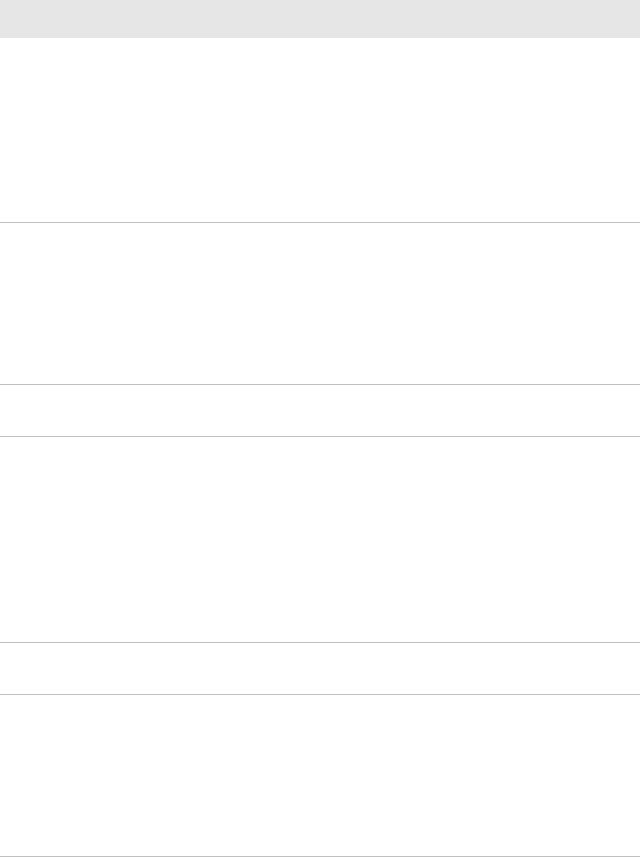
Chapter 2 — Connecting and Configuring the Printer
PD41 and PD42 Commercial Printer User’s Guide 51
Use the following table to understand the 802.1x settings.
Understanding the 802.1x Settings
Setting Description
EAP Type Choose the Extensible Authentication Protocol
(EAP) type:
•TTLS (default)
•LEAP
•PEAP
•EAP-FAST
•Off (disables 802.1x security)
Inner Authentication Choose the inner authentication method:
•PAP (TTLS only)
•MSCHAPv2
•EAP/MSCHAPv2
•EAP/MD5
•EAP/GTC
Outer Name
(TTLS only)
Specify the EAP identity passed in the clear.
The default is anonymous.
PAC- Key A-ID Info The Protected Access Credential (PAC) setting
is used to specify the PAC file used by EAP-
FAST authentication. This setting is
automatically filled up by the printer is
ACQUIRE_PAC is enabled and current
installed PAC file fails authenticating the
printer to the network. To manually import a
PAC file using a pass phrase, the pass phrase
should be given after the path of the PAC file.
Automatic Provision (PAC) Set Automatic PAC file Provisioning to on or
off.
Root Certificate The common name of the installed root CA
certificate. You can also specify a different
certificate (provided that it has already been
installed on the printer) by entering the path to
the new certificate in this field. If a pass phrase
is required, add it to the end of the path in the
form of “@passphrase”.

Chapter 2 — Connecting and Configuring the Printer
52 PD41 and PD42 Commercial Printer User’s Guide
Configuring SmartSystems Settings
Use the SmartSystems page to view or change the SmartSystems
server IP address and the master port number.
To configure the SmartSystems settings
1Click Network Admin > SmartSystems.
2View or change the settings.
3Click Submit SmartSystems settings.
Configuring the Printer Using PrintSet
PrintSet is a printer configuration tool that allows you to easily
change your setup parameters. You can also use the setup wizards in
PrinSet to guide you through common configuration tasks.
To configure the printer with PrintSet
1Make sure that you have a PC running Microsoft Windows 98 or
later.
2Download PrintSet from the Downloads page of the Intermec web
site at www.intermec.com.
3Connect your printer to your PC using a serial cable. For help, see
“Connecting the Printer to a PC Through the Serial Port” on
page 24.
Server Common Name #1
Server Common Name #2
(TTLS and PEAP only)
Specify common names. If you specify one
common name, the server certificate common
name must match this name for
authentication. If you specify two common
names, the server certificate common name
must match at least one of them. The default is
“” (any common name).
Server Certificate
Validation (TTLS and
PEAP only)
Enables certificate validation. Specifies
whether or not to check if the installed CA
certificate is the root of the server certificate.
Understanding the 802.1x Settings (continued)
Setting Description
Chapter 2 — Connecting and Configuring the Printer
PD41 and PD42 Commercial Printer User’s Guide 53
Configuring the Printer Using Commands Sent From Your PC
You can change configuration parameters by sending commands
directly to the printer using your terminal program (HyperTerminal)
and a serial or network connection.
If your printer uses the Fingerprint language, you use the SETUP
command, followed by the node, subnode, and parameters setting.
Here is a Fingerprint example that sets your media setting to labels
with gaps:
SETUP "MEDIA,MEDIA TYPE,LABEL (w GAPS)"
If your printer uses the IPL language, you would send this command:
<STX><SI>T1<ETX>
Fingerprint automatically sends feedback to HyperTerminal as you
type. If you want to see what you are typing with IPL, you need to
complete the following procedure.
To see IPL commands as you type
1From the HyperTerminal menu, select File > Properties > the
Settings tab.
2Click the ASCII Setup button.
3Select Echo typed characters locally.
4Click OK twice.
For more information on how to change configuration settings, see
either the Intermec Fingerprint Command Reference Manual or the
IPL Command Reference Manual.
Configuring the Printer Remotely Using SmartSystems
You can use SmartSystems Foundation to change configuration
settings on your printer. The printer ships with the SmartSystems
client loaded on it. The console is part of SmartSystems Foundation
and is available from the Intermec web site. To download
SmartSystems Foundation, go to www.intermec.com/products/
smrtsysfoundation/index.aspx.
Chapter 2 — Connecting and Configuring the Printer
54 PD41 and PD42 Commercial Printer User’s Guide
Upgrading the Firmware
The latest firmware and software is available for download from the
Downloads page on the Intermec web site at www.intermec.com.
You can upgrade the firmware on your printer using:
•PrintSet. You can download PrintSet from the downloads page for
the printer on the Intermec web site at www.intermec.com.
•a CompactFlash (CF) card or 2GB USB storage device.
•an Ethernet or 802.11 network connection.
•a serial or USB connection.
To download firmware updates
1Go to the Intermec web site at www.intermec.com.
2Click Support > Downloads.
3Use the Product Category, Product Family, and Product fields,
to select the PD41 or PD42.
4Click Submit. The latest available software appears on the page.
5Download the latest firmware version to your PC.
6Extract the .zip file to a folder on your PC.
To upgrade using PrintSet
1Download the latest version of PrintSet from the Intermec web
site at www.intermec.com.
2Select File > Add Printer. The Add Printer Wizard starts.
3Under My Printers, select your printer.
4Go to Printer > Firmware Wizard.
5Follow the steps to update your firmware.
To upgrade using a CF card or USB storage device
1Copy the firmware upgrade file to a CF card or USB device.
2Insert the CF card or USB device in the appropriate slot on the
back of your printer.
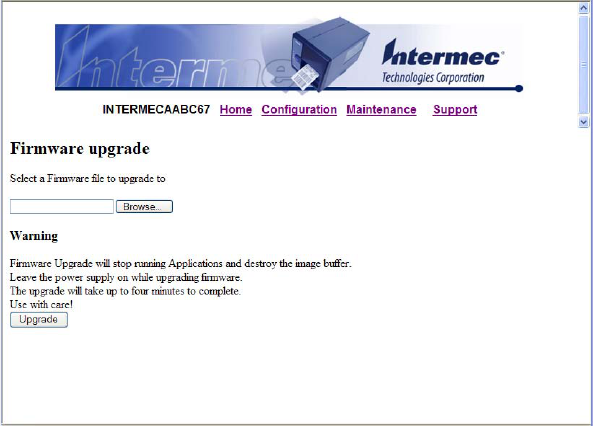
Chapter 2 — Connecting and Configuring the Printer
PD41 and PD42 Commercial Printer User’s Guide 55
To upgrade using a serial or USB connection
•Use Fingerprint or IPL commands to send the upgrade file to your
printer.
For help, see the Intermec Fingerprint Command Reference Manual or
the IPL Command Reference Manual.
To upgrade using an Ethernet or 802.11 network connection
1Start your web browser application.
2In the address field, enter the IP address of your printer.
3Press Enter. The home page of your printer appears.
4From the menu at the top of the page, click Maintenance. The
firmware upgrade screen appears.
5Click Browse and browse to the location of the firmware upgrade
file.
6Double-click the file, and then click Upgrade.

Chapter 2 — Connecting and Configuring the Printer
56 PD41 and PD42 Commercial Printer User’s Guide
Downloading Fonts and Graphics
The PD41 and PD42 support 15 scalable Unicode TrueType and
TrueDoc fonts as standard. The Unicode standard allows the use of
special characters for various languages including non-Latin fonts,
such as Arabic, Cyrillic, Chinese (including enhanced Simplified
Chinese GB18030), Japanese, Korean, and Hebrew.
You can download additional fonts to the Flash memory of the
printer using:
•PrintSet. You can download PrintSet from the downloads page for
the printer on the Intermec web site at www.intermec.com.
•Fingerprint or IPL commands. For help, see the Intermec
Fingerprint Command Reference Manual or the IPL Command
Reference Manual.
•a CompactFlash card or external 2GB USB mass storage device.
Note: Fingerprint firmware supports the download of any TrueType
font. IPL and ESim only support TrueType fonts provided by
Intermec.

57
33
Troubleshooting and Maintaining
the Printer
Use this chapter to troubleshoot and maintain the printer. This
chapter contains these sections:
•Troubleshooting the Printer
•Adjusting the Printer
•Maintaining the Printer
Chapter 3 — Troubleshooting and Maintaining the Printer
58 PD41 and PD42 Commercial Printer User’s Guide
Troubleshooting the Printer
You may have printer operation, print quality, or printer
communication problems at some time during the life of the printer.
It is easy to fix most of the problems and you will find solutions in
“Troubleshooting Printer Problems and Finding Solutions” on
page 61. If you cannot find the answer to your problem, you may need
to contact Product Support.
Contacting Product Support
Before you call Intermec Product Support, you may want to visit the
Intermec technical knowledge base (Knowledge Central). To do so, go
to www.intermec.com and click Support > Knowledge Central. If
you still need help after visiting Knowledge Central, you may need to
call Product Support. To talk to an Intermec Product Support
representative in the U.S.A. or Canada, call:
1-800-755-5505
Outside the U.S.A. and Canada, go to www.intermec.com and click
Contact Us to find your local Intermec representative.
Before you call Intermec Product Support, make sure you have the
following information ready:
•Printer serial number
•Firmware type and version
•Wireless or serial port settings
You can find all of the information listed above in the printer menu
system or on a testprint page .
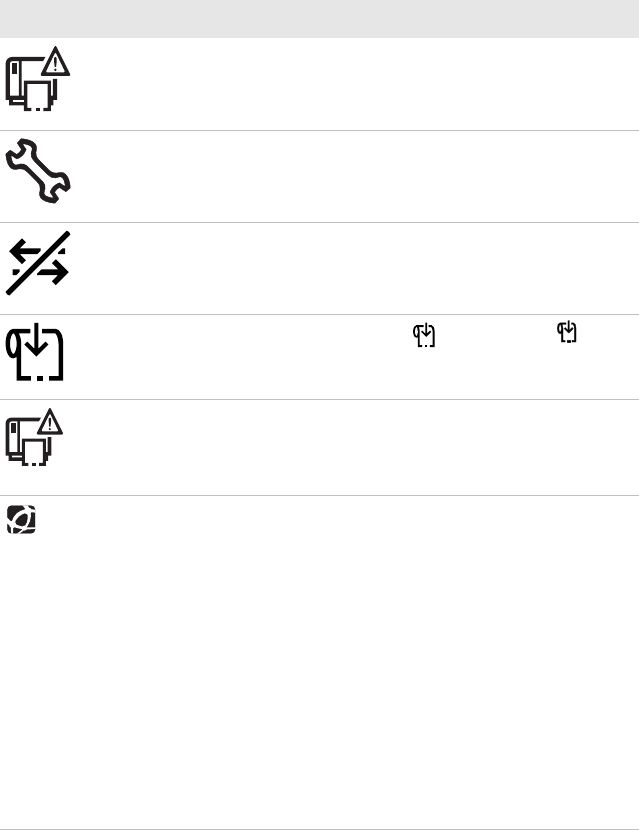
Chapter 3 — Troubleshooting and Maintaining the Printer
PD41 and PD42 Commercial Printer User’s Guide 59
Understanding Error Messages on the PD42
Use the following tables to troubleshoot some common error
messages you may see on the PD42 printer display. Some of the error
messages are specific to the type of firmware you have loaded on your
printer.
Possible PD42 Printer Error Icons and Messages
Error Icon Error Message Solution
Printhead lifted. Lower printhead.
Maintenance. The printer is upgrading its firmware.
Wait for it to complete the task.
IP link error. Check to see if the network cable has
been unplugged.
Press feed not done. Press Feed ( ) or Testfeed ( ).
Label not taken. Printing has been stopped because a
label is obstructing the label taken
sensor. Remove the label to resume
printing.
LSS too high, LSS too
low.
Label stop sensor errors can occur
when you perform a testfeed without
any media installed or if you have
incorrect media settings.
To fix this error
1Load the printer with media. For
help, see “The printers can enter
various states which indicate the
current mode of operation.” on
page 10.
2Restart the printer in Test mode
and select the appropriate media
type. For help, see “Using
Testmode” on page 65.
Test
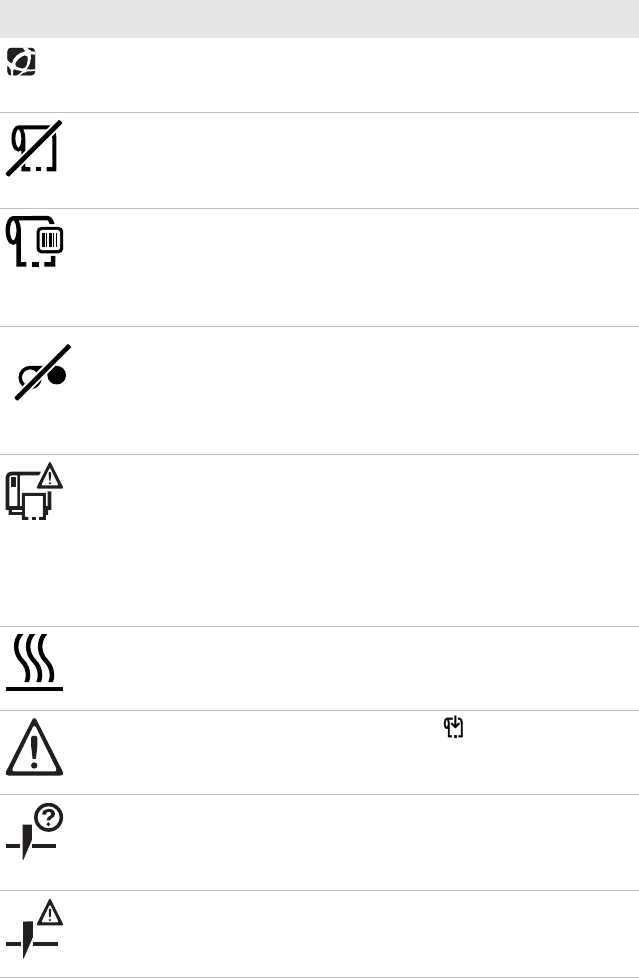
Chapter 3 — Troubleshooting and Maintaining the Printer
60 PD41 and PD42 Commercial Printer User’s Guide
‘
IP configuration error. The printer is trying to acquire an IP
address from the network. Wait until
the printer receives the IP address.
Out of media. Load media in printer. For help, see
“The printers can enter various
states which indicate the current
mode of operation.” on page 10.
Field out of label. You are attempting to print in an area
that extends beyond the “print
window.” See the appropriate printer
language command reference manual
for help setting the media parameters.
Ribbon empty. Try these solutions:
•Load thermal transfer ribbon. For
help, see “Loading Thermal
Transfer Ribbon” on page 17.
•
Label not found. The printer does not find a label gap
or black mark.
•Go into Setup mode and verify that
the label length parameter is
correct.
•Verify that the Media type settings
are correct.
Printhead hot. The printhead is overheated and needs
to cool down. Wait for prining to
resume automatically.
Testfeed not done. Press Testfeed ( ).
Cutter not found. A cut command has been sent to the
printer, but the printer cannot find
the cutter. Make sure the cutter is
installed properly.
Cutter not responding. Make sure the cutter is installed
properly.
Possible PD42 Printer Error Icons and Messages (continued)
Error Icon Error Message Solution
Test
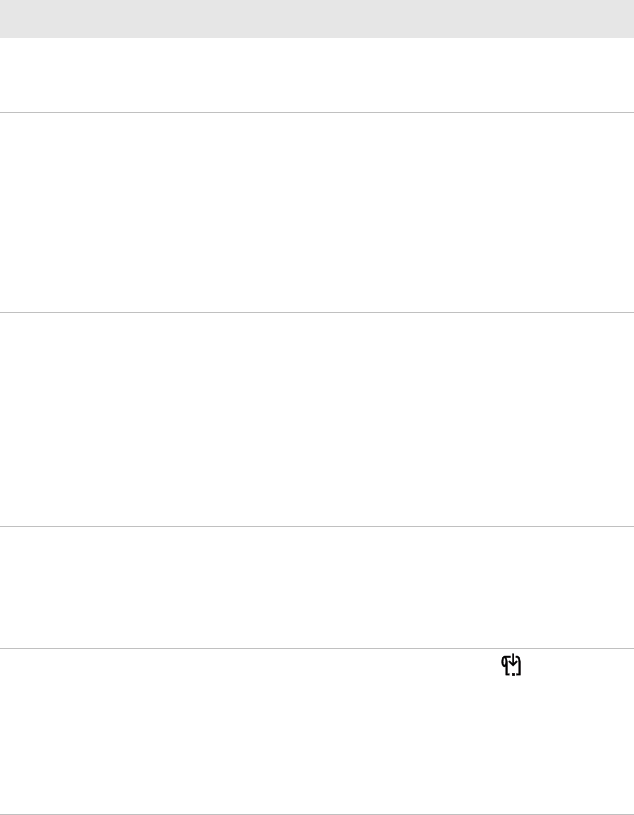
Chapter 3 — Troubleshooting and Maintaining the Printer
PD41 and PD42 Commercial Printer User’s Guide 61
Troubleshooting Printer Problems and Finding Solutions
Use the following table to troubleshoot common printer problems.
Printer Problems and Possible Solutions
Problem Possible Solution
The Power LED does
not light up when the
printer is switched on.
Check that the power cable is correctly connected
to the printer and the electrical outlet.
The Error LED turns
on after printing.
•Check to see if the printer is out of media or
ribbon.
•Check to see if media is jammed or tangled.
•Check to make sure the print mechanism is
locked and closed correctly.
•Check the cutter for problems.
•Check to make sure your application is working
correctly.
The Ethernet
connection is not
working.
•Check the network LED on the back of the
printer. A green LED should be flashing to
indicate network activity and a yellow LED
should be on solid if connected to a 100 Mbps
network.
•Make sure the Ethernet cable is connected
correctly to the back of the printer.
•Make sure you are using the correct Ethernet
cable.
A label is jammed after
printing.
•Clear the media jam. For help, see “Clearing
Media Jams” on page 70.
•If the label is stuck on the thermal printhead,
clean the printhead. For help, see “Cleaning
the Printhead” on page 80.l
When printing, the
printer is skipping
labels.
•Run a new testfeed by pressing ( ) on the
PD42 or by holding the print button more than
one second on the PD41.
•Make sure the label gap sensor is aligned
properly and that it is clean. For help, see
“Adjusting the Label Stop Sensor” on
page 75.
Test
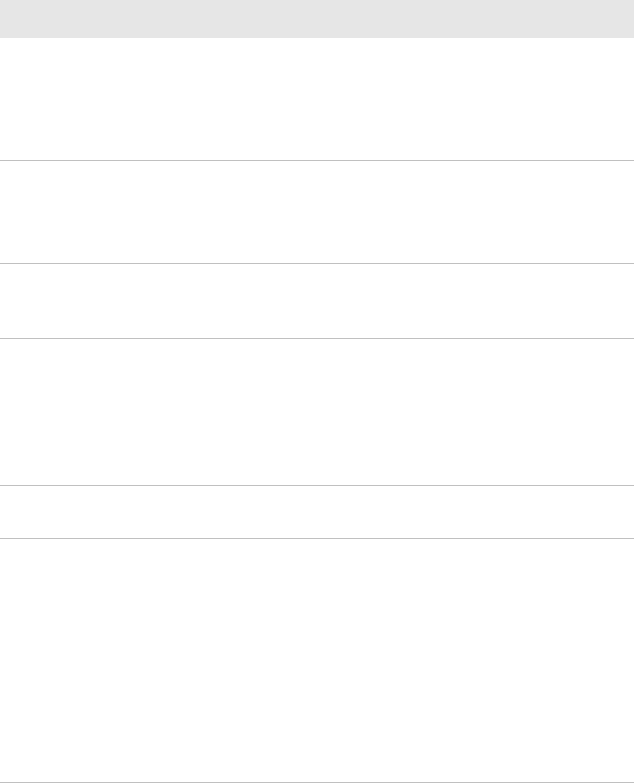
Chapter 3 — Troubleshooting and Maintaining the Printer
62 PD41 and PD42 Commercial Printer User’s Guide
When using the cutter,
the label is not cut
straight.
•Make sure the media thickness does not exceed
0.25 mm (9.8 mils).
•Make sure the media is loaded correctly and
that it runs as close to the center section of the
printer as possible.
When using the cutter,
the labels cannot feed
or abnormal pringin
occurs.
•Make sure the cutter is installed propoerly.
•Make sure the paper feed rods are sticky.
•Clean the media compartment. For help, see
“To clean the printhead” on page 80.
When using the
internal rewinder, the
printer malfunctions.
Make sure the media is loaded correctly.
The printer keeps
printing or feeding
when it should stop.
•Check the media settings.
•Check the label gap sensor position. For help,
see “Adjusting the Label Stop Sensor” on
page 75.
•Make sure the sensors are clean. For help, see
“To clean the printhead” on page 80.
Printing is slow. Make sure your printing application is working
correctly.
Printing is faded or
light.
•For Fingerprint: Adjust the the Constant,
Factor and Contrast media settings.
•For IPL: Adjust the Sensitivity setting.
•Make sure the printhead is clean. For help, see
“Cleaning the Printhead” on page 80.
•Check the printhead pressure. For help, see
“Adjusting Printhead Pressure” on page 72.
•Check the printhead dotline posistion. For
help, see “Adjusting Printhead Dot Line” on
page 73.
Printer Problems and Possible Solutions (continued)
Problem Possible Solution
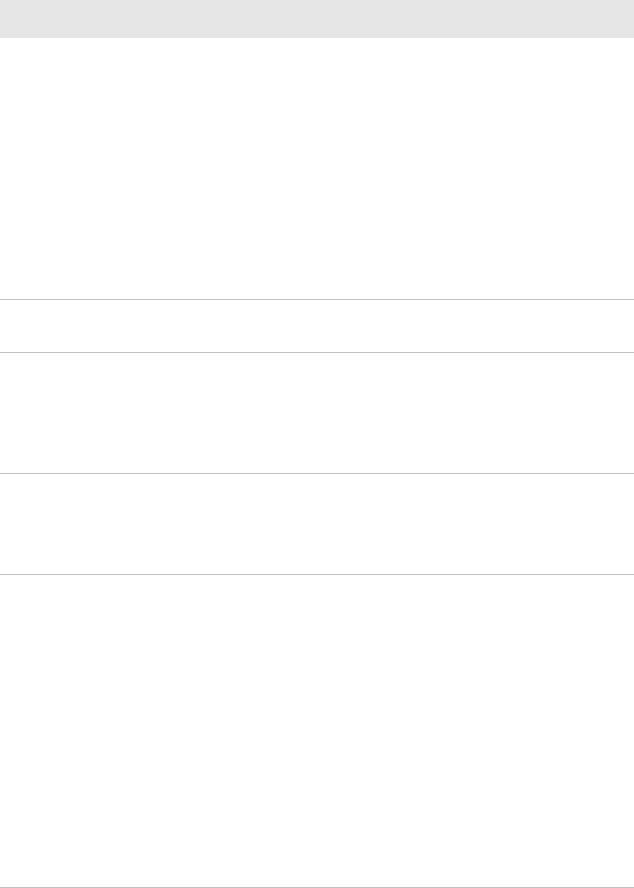
Chapter 3 — Troubleshooting and Maintaining the Printer
PD41 and PD42 Commercial Printer User’s Guide 63
The printer is working,
but nothing is being
printed.
•Printing on direct thermal media: Make sure
the media is loaded with the heat-sensitive side
facing the printhead.
•Printing with thermal transfer ribbon: Make
sure the ink-side of the ribbon faces the media.
For help, see “Loading Thermal Transfer
Ribbon” on page 17.
•Make sure you have the correct media type and
paper type selected.
•Make sure the printhead is correctly connected
to the print mechanism.
Only partial labels are
printing.
Check the printhead balance. For help, see
“Adjusting Printhead Balance” on page 71.
Part of the print image
is not printed along the
feed direction.
•Make sure the printhead is clean. For help, see
“Cleaning the Printhead” on page 80.
•Make sure the ribbon is not wrinkling. For help,
see “Preventing Ribbon Wrinkling” on
page 68.
The printout is uneven
across the media path.
•Check the printhead balance. For help, see
“Adjusting Printhead Balance” on page 71.
•Check the printhead pressure. For help, see
“Adjusting Printhead Pressure” on page 72.
The printout is not in
the correct position.
•Check for errors in the software application.
•Make sure the label gap sensor is clean. For
help, see “To clean the printhead” on
page 80.
•Check the position of the label gap sensor. For
help, see “Adjusting the Label Stop Sensor”
on page 75.
•Check the position of the edge guide and media
guide.
•Make sure you are using the correct media.
•Make sure the platen roller is clean and in good
condition. For help, see “To clean the
printhead” on page 80.
Printer Problems and Possible Solutions (continued)
Problem Possible Solution
Chapter 3 — Troubleshooting and Maintaining the Printer
64 PD41 and PD42 Commercial Printer User’s Guide
Troubleshooting Communication Problems
You can use Dump mode to verify that the printer is receiving data
correctly from the host.
Using the Line Analyzer in Fingerprint
In Dump mode, the printer runs a Fingerprint program called Line
analyzer. The Line Analyzer captures incoming characters on the
communication ports and prints them on one or more labels.
The easiest way to enter Dump mode is through Test mode or
Extended Test mode. For help, see “Using Testmode and Extended
Testmode to Troubleshoot” on page 65.
After the printer enters Dump mode, the printer tells you it has
entered Dump mode by printing it on a label. The printer is ready to
receive data. If you have a PD42, the Dump mode icon appears on the
screen.
While the printer is receiving data, the Ready-to-Work indicator
blinks. After a half of a second, if no more characters have been
received, the printer times out. The program considers the
transmission terminated and prints out a label.
Printable characters are printed in black-on-white. Control characters
and space characters (ASCII 000 to 032 dec) are printed in white-on-
black.
As long as a continuous string of characters is being received, the
program wraps the lines until the label is full and then starts to print
another label. After each character transmission, the following
information prints:
•Page number
•Number of characters printed on the label
•Total number of characters received so far
When you exit Dump mode, a final label prints to inform you that it
exited Dump mode.

Chapter 3 — Troubleshooting and Maintaining the Printer
PD41 and PD42 Commercial Printer User’s Guide 65
Using Dump Mode
When you enter Dump mode, the printer captures incoming
characters on the communications ports and prints them on one or
more labels.
You can access Dump mode in two different ways with slightly
different results:
•You can access Dump mode through Test mode or Extended Test
mode and you will receive printouts that look exactly like those
produced with the Line Analyzer program in Fingerprint. For
more information, see the previous procedure, “Using the Line
Analyzer in Fingerprint” on page 64.
•You can access Dump mode from the Setup menu and characters
will print on a continuous line, along with corresponding
hexadecimal numbers.
To enter Dump from the Setup menu
1Press to enter Setup mode.
2Navigate to Test/Service> Data Dump.
3Toggle to Yes and then press .
The printer is now in Dump mode.
To exit Dump mode
•Turn the printer off and then back on again.
Using Testmode and Extended Testmode to Troubleshoot
Use Testmode and Extended Testmode when you want to verify
printer settings, print test labels, restore factory default settings, or
enter Dump mode to troubleshoot. Testmode is a simple linear
sequence which requires little user input. Extended Testmode gives
you more options.
Using Testmode
Testmode is a simple linear sequence which requires little user input.
To use Testmode
1Turn off the printer.

Chapter 3 — Troubleshooting and Maintaining the Printer
66 PD41 and PD42 Commercial Printer User’s Guide
2Load media and ribbon (if necessary). For help see, “Loading
Media” on page 9 and “Loading Thermal Transfer Ribbon” on
page 15.
3Press and hold the Print button.
4Continue to keep the Print button pressed down and turn on the
Power switch. After approximately ten seconds, the printer screen
lights up, runs a media setup routine, enters Testmode, and three
of the LEDs start to flash one at a time (green, red, and then blue).
5Continue to press the Print button until the printer starts cycling
through the selectable media types: gap, mark and continuous.
6Select your media type by releasing the Print button when your
type of media appears on the screen.
insert illustration
The printer prints several test labels containing hardware, setup,
and network information and then enters Dump mode.
7Press the Print button once or press the Cancel soft key ( ) to
exit Dump mode.
8You can also save the dump by pressing the Save ( ) soft key.
Using Extended Testmode
Use Extended Testmode to run additional tests such as:
•printing test labels.
•running a Testfeed in slow mode.
•entering Dump mode.
•resetting to factory defaults.
To run Extended Testmode
1Make sure the printer is turned off, loaded with media, and that
the printhead is lifted.
2Press and hold the Print button.
3Continue to keep the Print button pressed down and turn on the
Power switch. After approximately ten seconds, the printer enters
Extended Testmode.
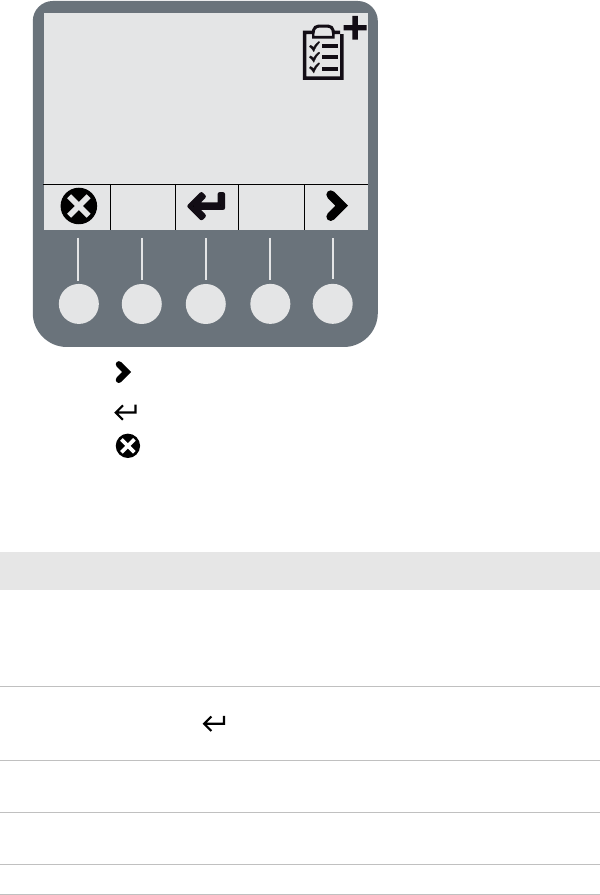
Chapter 3 — Troubleshooting and Maintaining the Printer
PD41 and PD42 Commercial Printer User’s Guide 67
All three LEDs flash rapidly four times to signal that Extended
Testmode is active.
4Release the Print button and lower the printhead. You are now in
Extended Testmode and the following screen appears.
•Press to cycle through the different options.
•Press to select a test function.
•Press to exit Extended Testmode.
5Lower the printhead.
Understanding the Functions in Extended Testmode
Function Description
Select Media When you select your media, the printer performs a
slow sensor calibration (slow testfeed). Performing a
slow testfeed can help resolve gap/mark detection
problems.
Test Labels
Setup Info
You can print configuration labels one at a time.
Press to print the next label. The screen shows
which label is next.
Dump Mode Enter Dump mode. For more information on Dump
mode, see “Using Dump Mode” on page 65.
Factory Default Restore factory default settings. Select the option
and then follow the onscreen instructions.
Setup and Exit Exit Extended Testmode and enter Setup mode.
TEST
SELECT MEDIA
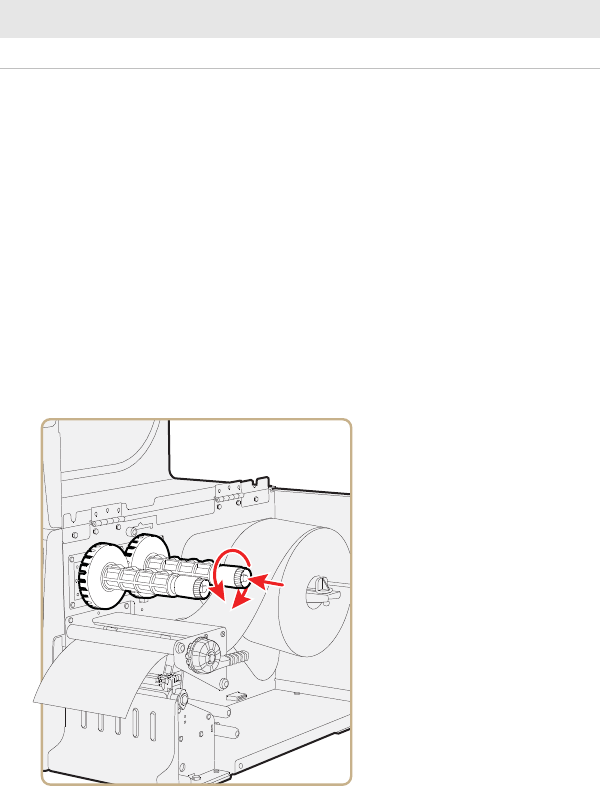
Chapter 3 — Troubleshooting and Maintaining the Printer
68 PD41 and PD42 Commercial Printer User’s Guide
Adjusting the Printer
Use this section to perform adjustments to help solve problems
related to print quality.
Preventing Ribbon Wrinkling
If you have problems with thermal transfer ribbon getting wrinkled,
try adjusting the the ribbon tension or the ribbon shield.
To adjust the ribbon tension
1Push in on the end knob of the ribbon supply hub.
2Rotate the knob:
•clockwise to increase the tension.
•counterclockwise to decrease the tension.
If your labels look like the following illustration, you may want to try
adjusting the ribbon shield.
Exit Exit Extended Testmode.
Understanding the Functions in Extended Testmode
Function Description
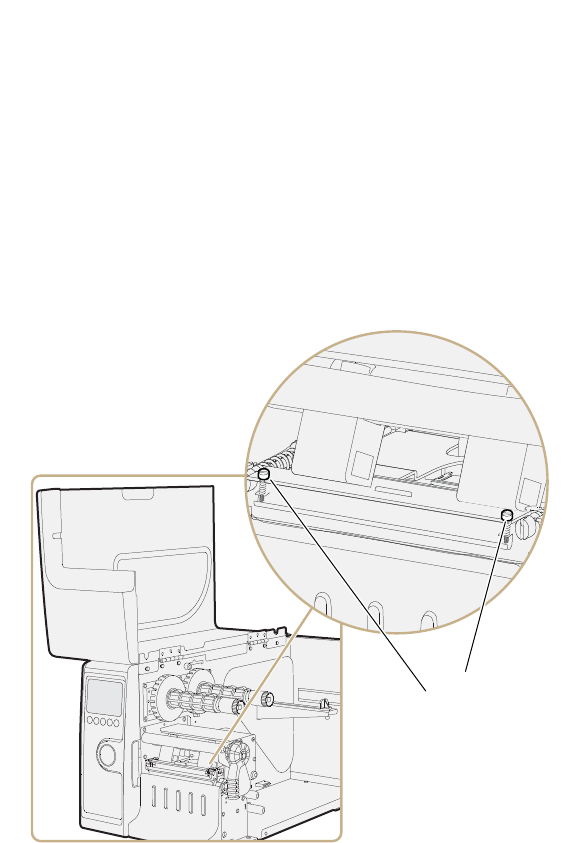
Chapter 3 — Troubleshooting and Maintaining the Printer
PD41 and PD42 Commercial Printer User’s Guide 69
Low Quality Printouts Caused by Ribbon Wrinkling
To adjust the ribbon shield
1If the label printout matches:
•Test Label A, turn screw A clockwise.
•Test Label B, turn screw B clockwise.
2Twist the screw a half-turn and perform a new test print.
1234567890
Test Label A
1234567890
Test Label B
AB

Chapter 3 — Troubleshooting and Maintaining the Printer
70 PD41 and PD42 Commercial Printer User’s Guide
3Continue adjusting the ribbon shield screws until you achieve
good printout quality.
Clearing Media Jams
Common causes of media jams include media not being loaded
properly or the printer not being maintained properly.
To clear a media jam
1Turn off the printer.
2Pull out on the printhead lever and turn it counterclockwise to lift
the printhead.
3Pull the media away from the print mechanism.
If the media has been wound up or is stuck on the platen roller,
carefully remove it by hand without using any sharp tools that can
damage the platen roller or the printhead.
4Cut off any damaged or wrinkled part of the media.
5Check to see if adhesive material is sticking to parts of the print
mechanism. If you need to clean the printhead, see “Maintaining
the Printer” on page 79.
6Reload the media. For help, see “The state of the printer also
determines the functions and icons that are active in the
screen.” on page 11.
7Turn on the printer power.
8Press the Print button the adjust the media feed.
Adjusting the Printhead
Keeping the printhead properly balanced is crucial for obtaining high-
quality printouts. Adjusting the printhead consists of adjusting the:
Note: Do not exceed two full turns of a ribbon shield screw or the
media may not feed smoothly. If this situation happens, turn the
screws counterclockwise completely and start over.
Note: Avoid rotating the platen roller. You may permanently
damage the electronic components.
Chapter 3 — Troubleshooting and Maintaining the Printer
PD41 and PD42 Commercial Printer User’s Guide 71
•printhead balance.
•printhead pressure.
•printhead dotline.
Adjusting Printhead Balance
The printer is adjusted at the factory for full-width media. If you are
using media that is less than full-width, Intermec recommends that
you adjust the position of the printhead balance boxes so that the
printhead is correctly pressured against the media. If your printouts
are lighter on one side than the other, it is most likely due to an
unbalanced printhead.
To adjust the printhead balance
1If you have installed thermal transfer ribbon, remove it.
2Pull out on the printhead lever and turn it counterclockwise to lift
the printhead.
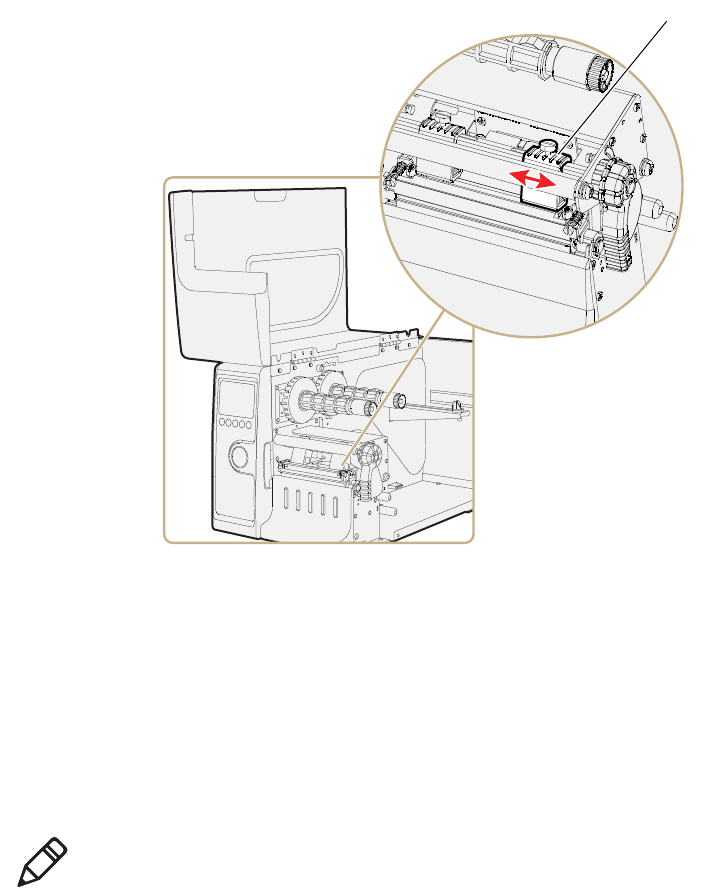
Chapter 3 — Troubleshooting and Maintaining the Printer
72 PD41 and PD42 Commercial Printer User’s Guide
3Move the balance boxes:
•outward for wider media.
•inward for narrower media.
4Close the printhead and load the ribbon.
5Test and readjust the balance boxes if necessary.
Adjusting Printhead Pressure
The pressure of the thermal printhead against the platen roller is
adjusted at the factory. You may need to readjust hte printhead
pressure if the printing is weaker on one side of the media, or if the
thermal transfer ribbon starts to crease (indicated by unprinted white
streaks along the media feed direction).
Balance box
Note: Before adjusting the printhead pressure, try to move the outer
balance box as described in the the previous procedure, “Adjusting
Printhead Balance.”
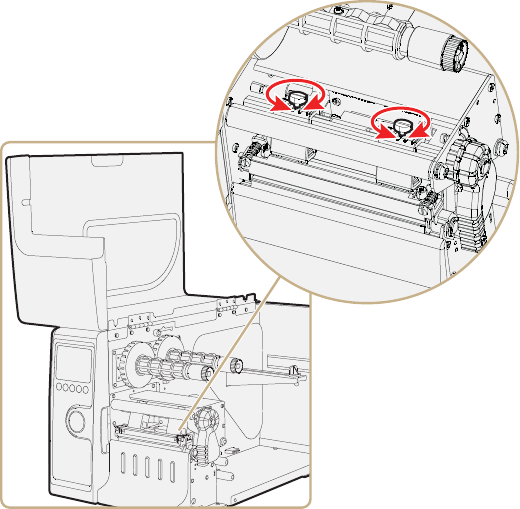
Chapter 3 — Troubleshooting and Maintaining the Printer
PD41 and PD42 Commercial Printer User’s Guide 73
To adjust the printhead pressure
1If you have installed thermal transfer ribbon, remove it.
2Pull out on the printhead lever and turn it counterclockwise to lift
the printhead.
3Using a slotted screwdriver, turn the screw at the top of the
balance boxes:
•clockwise to increase pressure.
•counterclockwise to decrease pressure.
4Close the printhead and load the ribbon.
5Test and readjust the pressure if necessary.
Adjusting Printhead Dot Line
When using thick or stiff media, you need to move the printhead
forward so that the dot line is aligned precisely with the top of the
platen roller. You also need to make sure that the printhead dot line
and the platen roller are parallel.
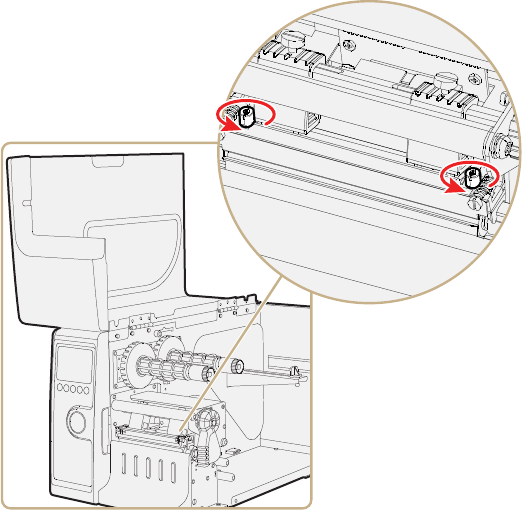
Chapter 3 — Troubleshooting and Maintaining the Printer
74 PD41 and PD42 Commercial Printer User’s Guide
To adjust the printhead dot line
1If you have installed thermal transfer ribbon, remove it and close
the printhead.
2Use a slotted screwdriver to turn the two screws at the top of the
printhead bracket counterclockwisea single turn.
3Pull out on the printhead lever and turn it counterclockwise to lift
the printhead.
4Carefully turn both screws, at the front of the printhead, clockwise
a quarter of a turn at a time.
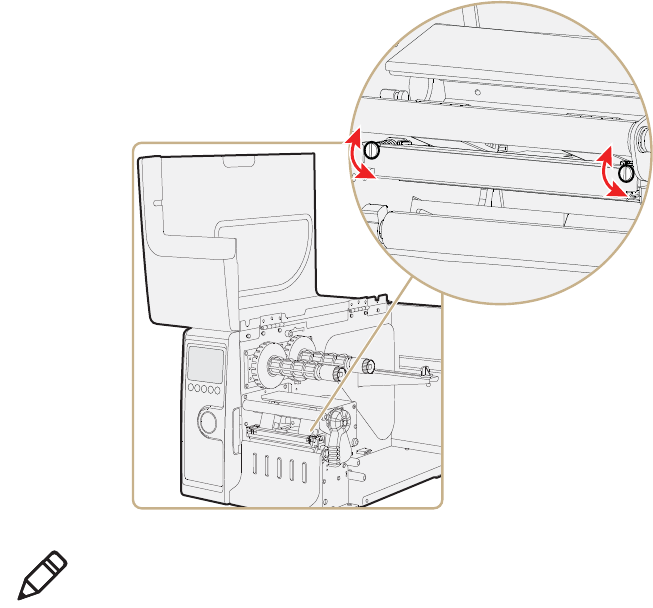
Chapter 3 — Troubleshooting and Maintaining the Printer
PD41 and PD42 Commercial Printer User’s Guide 75
5Close the printhead and using the slotted screwdriver to turn the
two screws at the top of the printhead bracket clockwise a single
turn.
6If you are using thermal transfer ribbon, load it.
7Test and readjust if necessary.
Adjusting the Label Stop Sensor
The label stop sensor (also called label gap sensor or black mark
sensor) is a photoelectric sensor that controls the media feed by
detecting gaps between labels, or slots or black marks in continuous
stock. For the sensor to work, it must be aligned with the gaps, slots,
or marks on the media. If you are using irregularly shaped labels, align
the sensor with the front tip of the labels.
Note: Be sure you make identical adjustments on both screws. If you
are unsure, tighten both screws completely by turning them
counterclockwise as far as they will go, and then start over.
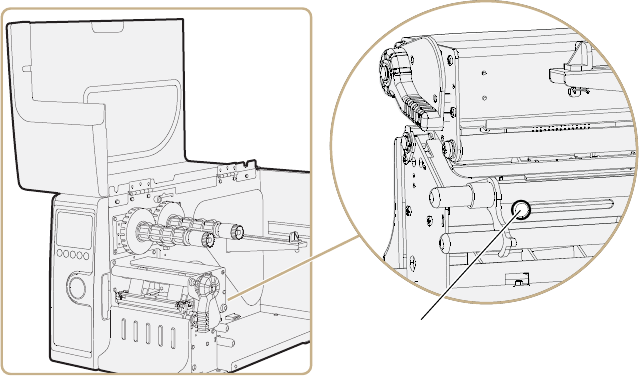
Chapter 3 — Troubleshooting and Maintaining the Printer
76 PD41 and PD42 Commercial Printer User’s Guide
To adjust the label stop sensor position
1Pull out on the printhead lever and turn it counterclockwise to lift
the printhead.
2Use the sensor lever at the rear side of the print mechanism to
move the sensor inward or outward.
3Check the point of detection from the front with the printhead
lifted.
Sensor lever
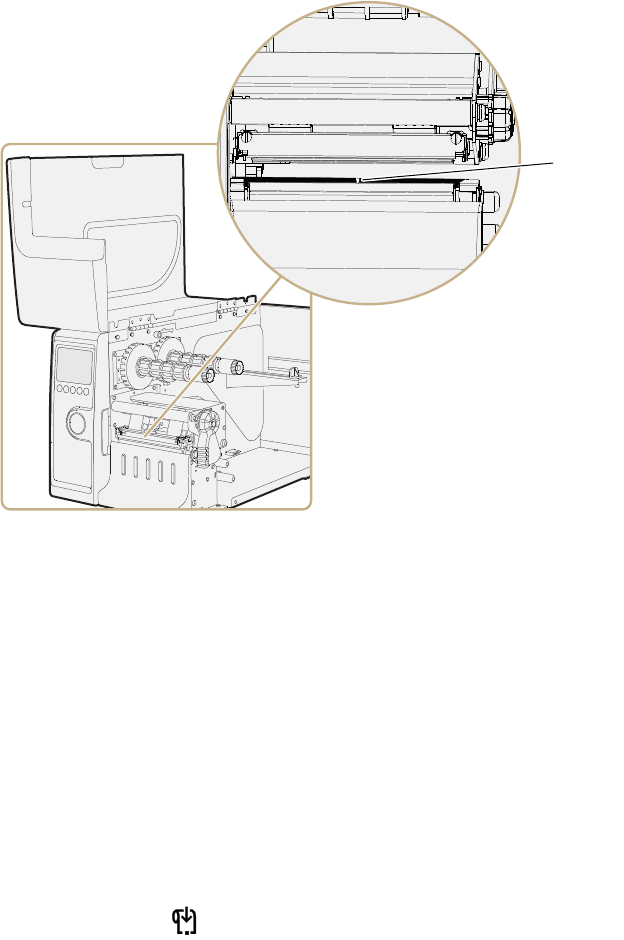
Chapter 3 — Troubleshooting and Maintaining the Printer
PD41 and PD42 Commercial Printer User’s Guide 77
If you are having detection problems, you can test the label stop
sensor in Setup mode. The label stop sensor tests can determine
whether the sensor is in the right position, if it is blocked by dust or
stuck labels, or if it is defective in some way. Setup mode has these two
test functions:
•LSS Auto: Checks to make sure that the label stop sensor is
working properly and can detect gaps, slots, and black marks.
•LSS Manual: Shows the sensor setting established by the latest
Testfeed. LSS Manual is intended to be used by Intermec service
personnel only.
To run the LSS Auto test
1Make sure the printer is correctly configured for the type of media
you are using.
2Press Testfeed ( ).
3Make sure that there is a label, not a gap or black mark, at the
sensor.
Point of
detection
Test

Chapter 3 — Troubleshooting and Maintaining the Printer
78 PD41 and PD42 Commercial Printer User’s Guide
4Make sure that the media runs as close to the center of the printer
as the guides will allow.
5Press Setup ().
6Go to Print Defs > LSS Test > LSS Auto. The cursor will in the
center of the screen as shown below.
7For gap or slot detection: Lift the printhead and slowly pull out
the media in the media feed direction. When the label stop sensor
detects a gap or a detection slot, the cursor moves to the right.
8For black mark detection: Lift the printhead and slowly pull out
the media in the feed direction. When the label stop sensor detects
a black mark, the cursor moves to the left.
If the cursor behaves as described in Steps 7 and 8, the label stop
sensor is working and is properly aligned.
LSS AUTO
LSS AUTO
LSS AUTO

Chapter 3 — Troubleshooting and Maintaining the Printer
PD41 and PD42 Commercial Printer User’s Guide 79
If the cursor does not detect a gap, slot, or black mark, check the
following:
•Is the label stop sensor laterally aligned with the slots or black
marks?
•Is the transfer ribbon properly loaded so it does not interfere
with the label stop sensor? For help, see “Loading Thermal
Transfer Ribbon” on page 17.
•Are the label stop sensor guides clean? If not, clean them as
described in the next section “Maintaining the Printer.”
•Does the media have preprint information on it that can make
detection harder?
•Is there too little contrast between the black marks and the
surrounding areas?
•Is the label liner not transparent enough?
•Does the label stop sensor work with another type of media?
Maintaining the Printer
To ensure high productivity and a long life for your printer, Intermec
recommends that you regularly inspec the printer and its
environment to make sure that it is operated under optimal
conditions. Keep the printer in a dry area, away from large electrical
motors, welders, and similar products that might affect printer
operation.
Clean your printer regularly to maintain the quality of your labels and
extend the life of your printer.
If you open the electronics cover, you will void the warranty and
may cause damage to the internal components. Opening the
electrical cover exposes the user to shock hazards which may
result in injury or death.
Always turn off the printer and unplug the power cord before
cleaning the printer.

Chapter 3 — Troubleshooting and Maintaining the Printer
80 PD41 and PD42 Commercial Printer User’s Guide
Cleaning the Printhead
Cleaning the printhead on a regular basis prolongs the life of the
printhead and ensures that you maintain high print quality. You
should clean the printhead with cleaning cards or a cotton swab
moistened with isopropyl alcohol. Ideally, you should clean the
printhead every time you load a new supply of thermal transfer
ribbon.
To clean the printhead
1Open the media cover.
2Remove the media and ribbon.
3Pull out on the printhead lever and turn it counterclockwise to lift
the printhead.
4Use a cleaning card or a soft cotton swab moistened with isopropyl
alcohol to dissolve any contamination on the line of heat-emitting
dots at the front/bottom of the printhead.
5Wait 30 seconds and carefully rub off any contamination.
6Repeat Steps 4 and 5 if necessary.
7Allow the printhead to dry for a minute or more before loading a
new supply of media and ribbon.
Cleaning the Media Compartment
Regular cleaning of the printer’s media compartment ensures
smoother printing operation and avoids problems with media jams.
Isopropyl alcohol is a highly flammable, moderately toxic, and
mildly irritating substance.
Never use hard or sharp tools to peel away stuck labels or other
material. The printhead is delicate and can easily be damaged.

Chapter 3 — Troubleshooting and Maintaining the Printer
PD41 and PD42 Commercial Printer User’s Guide 81
Use a soft cloth moistened with isopropyl alcohol to clean the inside
of the printer.
Be sure to keep the following parts clean:
•Drive roller and tear bar
•Media edge guides and media path
•Label sensors
insert illustration?
If there are stuck labels, or adhesive residue from labels, peel as much
as possible with your fingers, and then use isopropyl alcohol to
dissolve the remaining adhesive.
Cleaning the Exterior of the Printer
Make sure to keep the exterior of the printer clean, this will reduce the
risk of dust or foreign particles reaching the inside of the printer and
affect printer functionality.
Use a soft cloth, possibly moistened with water or a mild detergent
when cleaning the printer externally. Make sure to keep the surface
surrounding the printer clean as well.
Isopropyl alcohol is a highly flammable, moderately toxic, and
mildly irritating substance.
If you use the printer in an environment where the premises are
cleaned by a water hose or steam, move the printer to another
room or cover it very carefully with a plastic sheet and make sure
that the power cord is unplugged.
Chapter 3 — Troubleshooting and Maintaining the Printer
82 PD41 and PD42 Commercial Printer User’s Guide